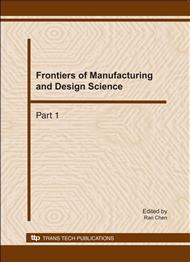p.2818
p.2822
p.2827
p.2832
p.2837
p.2842
p.2847
p.2852
p.2857
The Evaluation of Ductile Fracture Criteria (DFC) of 6061-T6 Aluminum Alloy
Abstract:
As one of the principal failures, ductile fracturing restricts metal forming process. Cockcroft-Latham fracture criterion is suited for tenacity fracture in bulk metal-forming simulation. An innovative approach involving physical compression experiments, numerical simulations and mathematic computations provides mutual support to evaluate ductile damage cumulating process and ductile fracture criteria (DFC). The results show that the maximum cumulated damage decreases with strain rate rising, and the incremental ratios, that is damage sensitive rate, vary uniformly during the upsetting processes at different strain rates. The damage sensitive rate decreases rapidly, then it becomes stability in a constant 0.11 after true strain -0.85. The true strain -0.85 was assumed as the fracture strain, and the DFC of 6061-T6 aluminum alloy is almost a constant 0.2. According to DFC, the exact fracture moment and position during various forming processes will be predicted conveniently.
Info:
Periodical:
Pages:
2837-2841
Citation:
Online since:
December 2010
Authors:
Keywords:
Price:
Сopyright:
© 2011 Trans Tech Publications Ltd. All Rights Reserved
Share:
Citation:


